Final Project:

I'm thrilled to introduce the GameShine, a bespoke gaming console that merges retro charm with contemporary technology.
The GameShine Console merges classical design with modern technology, showcasing a vibrant ILI9341 LCD 2"8 display powered by the upgraded XIAO ESP32S3 microcontroller for enhanced performance. It features creatively integrated SNES controller buttons connected to touch-sensitive pins, enriching interaction. This console supports customizable games such as "Space Trash" and "GalaFab," demonstrating its versatility in gaming. Styled after Adafruit's PiBoy and resembling a Pokeball with its striking red and transparent filament casing, the GameShine reveals its sophisticated internal components, adding educational value.
I personally oversaw the electronics design and production, ensuring optimal integration and functionality. The GameShine Console represents a blend of nostalgia and innovation, serving as a platform where gaming tradition meets technological advancement.

What is a "GameShine"?
As a passionate gamer and creator, my journey into the world of gaming consoles began with a cherished memory - my very first gaming console, a yellow Game Boy, a heartfelt gift from my cousin. It wasn't just a device; it was a gateway to countless adventures and the start of my lifelong passion for gaming. I remember spending hours on end playing Pokémon, exploring every nook and cranny of its pixelated world. That experience left an indelible mark on me, igniting a desire to continue the legacy of the beloved Game Boy. But this time, I want to create something of my own, a homage to the past with a vision for the future. This is how the idea of the GameShine console was born.

The GameShine console is my tribute to the classic Game Boy, reimagined for today's technology and gaming culture. I envisioned a device that not only pays homage to its predecessor but also expands on it, offering a variety of games and modern features while maintaining the charm and simplicity that captured my heart as a child.
Conceptualization
Design and features:

The essence of the GameShine console is deeply rooted in nostalgia, yet it's designed with an eye towards the innovative and the futuristic. My vision was to craft a device that honors the iconic Game Boy's legacy while embracing the advancements in technology and gaming culture. The console's design is a careful amalgamation of the old and the new—a sleek, ergonomic body reminiscent of the Game Boy, but infused with my personal aesthetic and functional enhancements.
Central to the GameShine console is its gaming experience, which I've meticulously planned to be both reminiscent of the past and thrillingly forward-looking. I've deliberated extensively on the choice of the display, caught between the allure of a high-resolution screen that could bring games to life with vivid colors and sharp details, and the charm of LED displays, which can change colors and offer a unique, retro-inspired visual experience. This decision is crucial, as it influences not just the visual fidelity of the games but also the console's battery life and overall aesthetic. The high-resolution screen promises a modern gaming experience, while the LED option beckons with its nostalgic appeal and energy efficiency.
For controls, I designed custom 3D printed buttons and a D-pad, ensuring they provide the perfect tactile feedback for an immersive gaming experience. These controls are a nod to the past, yet refined for the future.
Sustainability, Legacy, and the Path Forward:
My vision for the GameShine console is not merely to recreate a piece of gaming history but to forge a legacy that stands the test of time. By offering the flexibility to play a diverse array of games, I aspire to make the GameShine a beloved treasure for gamers across generations. It's a bridge between the joy I experienced with my yellow Game Boy and the endless possibilities of today's gaming landscape. As I continue to refine the GameShine, balancing between the allure of a high-resolution display and the unique charm of color-changing LEDs, my goal remains steadfast—to create a console that embodies the essence of handheld gaming's golden era, infused with the innovations of the present and the dreams of the future. This is more than just a project; it's a tribute to my first gaming love, an endeavor to continue a legacy, and a dream to bring unparalleled joy to gamers around the world.
Concept and Design:
- A and B Buttons: Classic gaming buttons for intuitive gameplay, designed with tactile feedback in mind.
- Cross (Directional) Buttons: Ergonomically designed for precise control and navigation within games.
- LED Display or High-Resolution Screen: Still under consideration; the LED option offers a unique, retro feel with color-changing capabilities, while the high-resolution screen provides vivid and sharp graphics.
- Custom-Produced PCB: The heart of the GameShine, designed to efficiently integrate all electronic components and functionalities.
- WiFi and Bluetooth Connectivity: For multiplayer gaming, online leaderboards, and firmware updates, enhancing the console's interactivity and versatility.
- 3D Printed Components: Utilized for custom buttons and structural elements, allowing for a personalized touch and rapid prototyping.
- Molded Casing: Provides a durable and comfortable housing for the console, ensuring it's ready for hours of gaming.
User Demographics:
"The GameShine" targets a diverse user base, making it an ideal choice for:
- Millennial Retro Gamers.
- Casual Gamers.
- Tech Enthusiasts and Hobbyists.
- Educational Institutions.
Research and Development:
To refine and enhance "The Shine," the following resources are crucial:
- Lameboy: Provides a handful insight into the process of replicating a GameBoy using an esp12.
- PiGRRL - Raspberry Pi Gameboy: A handmade Gameboy made using Raspberry Pi.
- ESP32 NES: A handmade NES Emulator using an ESP32.
- PORTABLE Space Trash Game Console: A Game Console made using a XIAO ESP32C3 and a game called Space Trash.
- ESP32 Handheld Game Console A Game Console made using an ESP32.
- NoFrendo A NES Emulator for the ESP32.
Conclusions and Future Prospects:
The development of the GameShine console represents a unique fusion of nostalgia, modern technology, and community engagement in gaming. By incorporating elements like 3D printing, molding, laser cutting, and advanced PCB design, along with the flexibility of programming through MicroPython, the GameShine not only pays homage to classic gaming consoles but also paves the way for future innovations in handheld gaming devices.
- Expanded Game Library: As the community around the GameShine grows, so too will the library of games. This growth will be fueled not just by professional developers, but by gamers and enthusiasts who have the tools to create and share their own games.
- Enhanced Connectivity Features: Future iterations of the GameShine could see improved networking capabilities, facilitating easier game sharing, multiplayer experiences, and access to a cloud-based library of games and apps.
- Integration with Emerging Technologies: Looking ahead, there's potential to integrate emerging technologies such as augmented reality (AR), virtual reality (VR), and artificial intelligence (AI) to create new gaming experiences. For example, AI could be used to adapt game difficulty in real-time, while AR and VR could open up new forms of interactive gameplay.
- Sustainability and Scalability: As the project matures, considerations around sustainable production, scalability, and the environmental impact of the device will become increasingly important. Innovations in eco-friendly materials and energy-efficient designs will play a crucial role in the console's evolution.
Final Product:
.gif)
I'm excited to present to you the culmination of my passion for gaming and technology—the GameShine, a custom-built gaming console that represents a blend of nostalgic design and modern functionality.
Design:
The design of the GameShine is inspired by Adafruit's PiBoy and was adapted using Fusion360.
Mockup sketches and adaptations that were going to be edited into Adafruit's PiBoy Design.
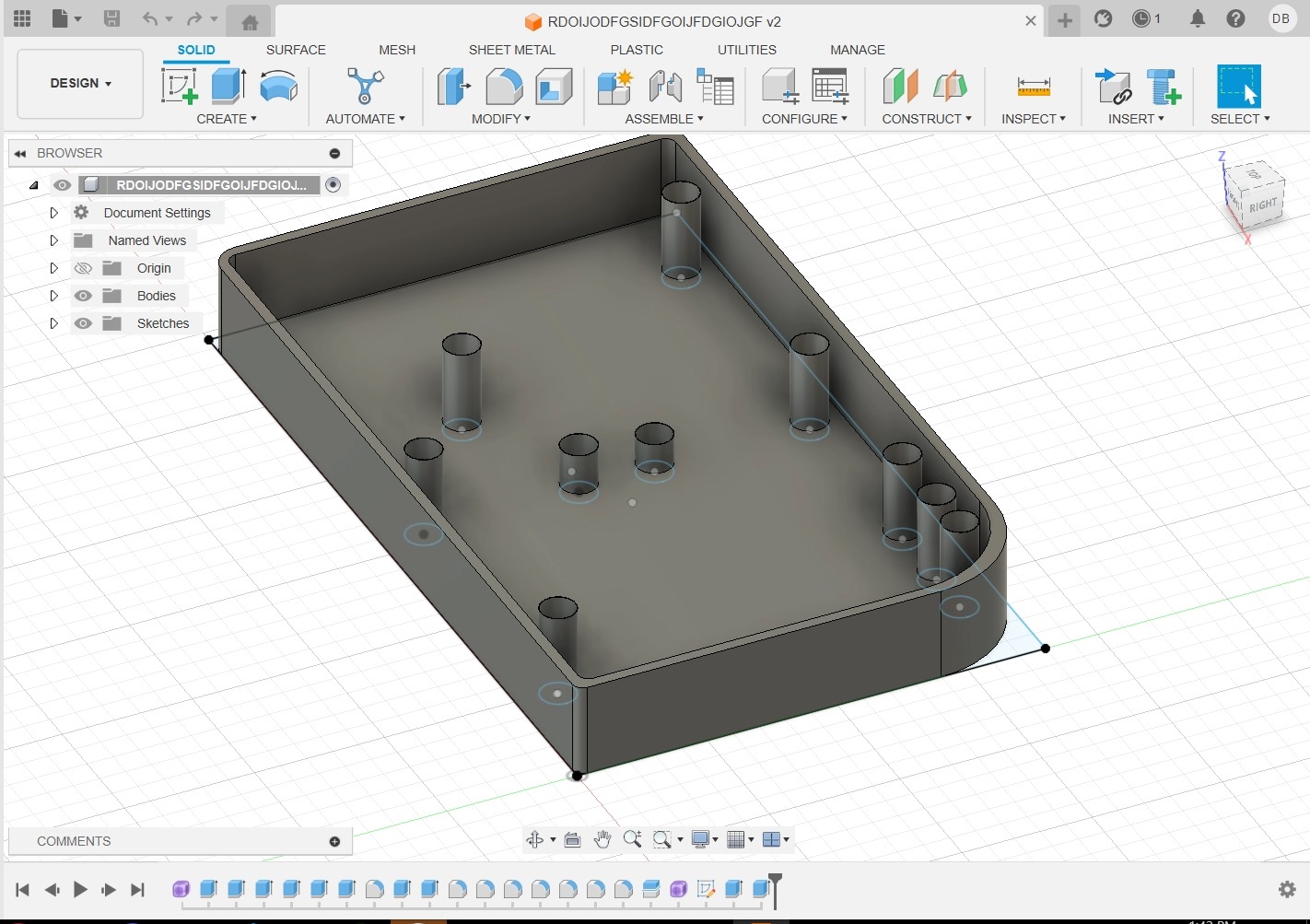
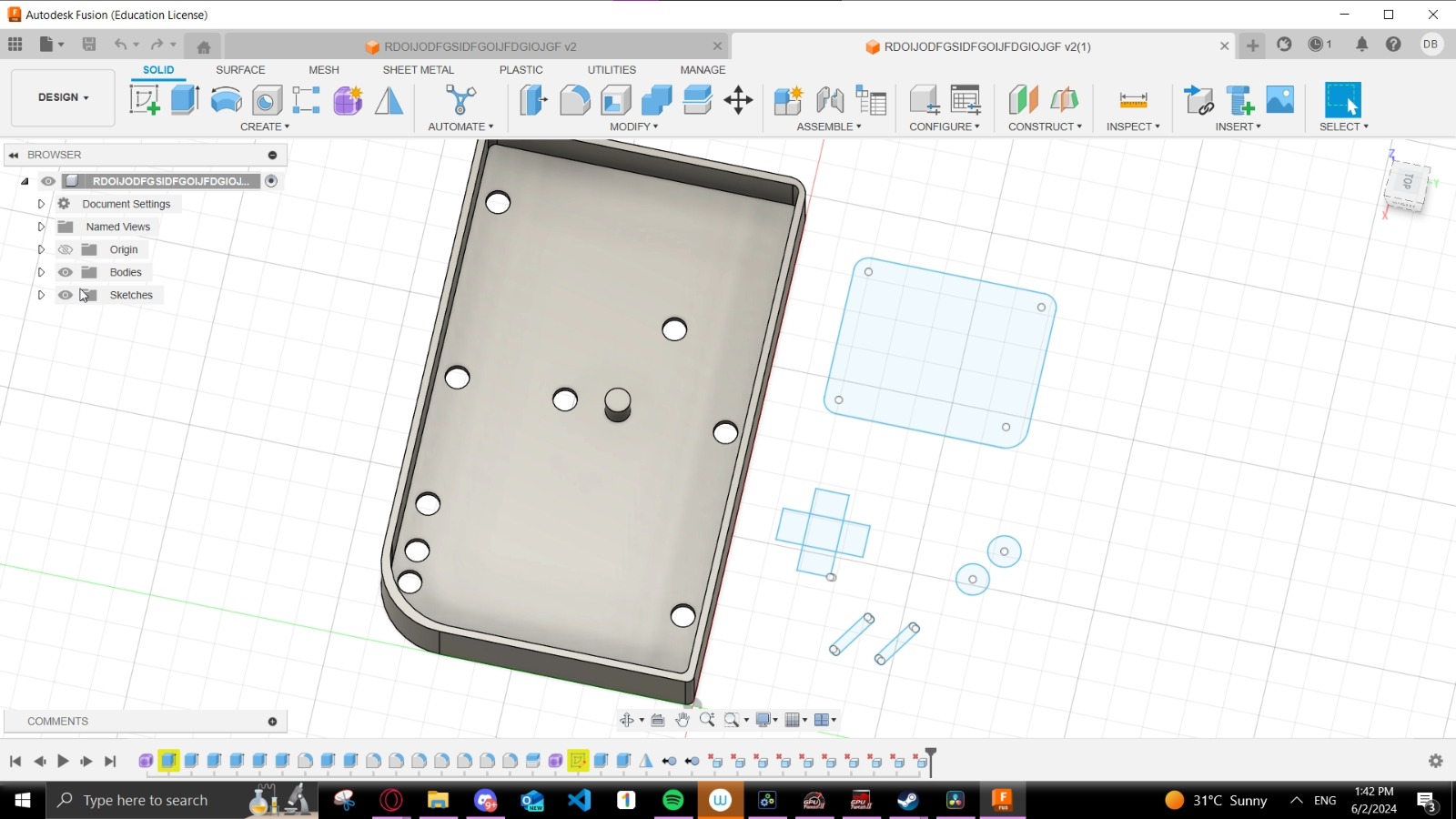
3D Renders.
3D Printing:
Yet the design is tailored to encapsulate the spirit of a Pokeball with its red and transparent filament case. This choice not only makes the console visually striking but also functional, as players can see the intricate wiring inside, similar to a resin case, adding an educational element to the design.


Assembled 3D Printed Parts:
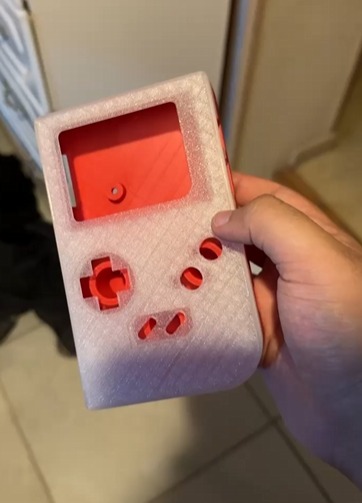
Lasercutted GameShine MDF Case:
The GameShine Console not only blends classical design with advanced technology but also features a unique aesthetic touch with a laser-cut GameShine Case. This additional case, designed to overlay the main console body, mimics a wood-like design through the use of MDF material, adding a refined, classic look that complements its modern internals.
Crafted with precision, the case fits perfectly atop the GameShine, enhancing its appearance while allowing easy access to its controls and display. This careful design ensures that all elements of the console are seamlessly integrated, providing both protective functionality and an elevated visual appeal.
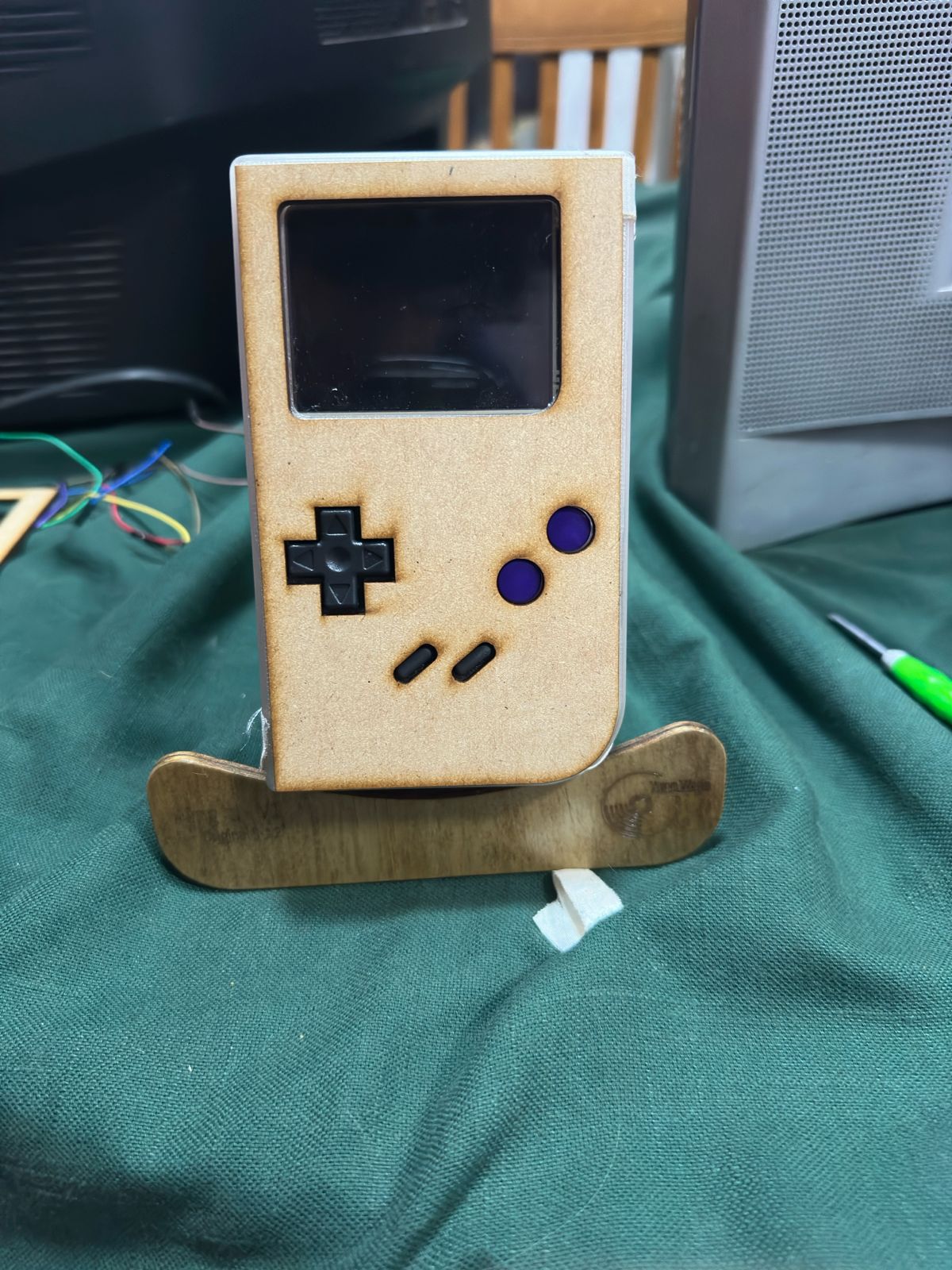
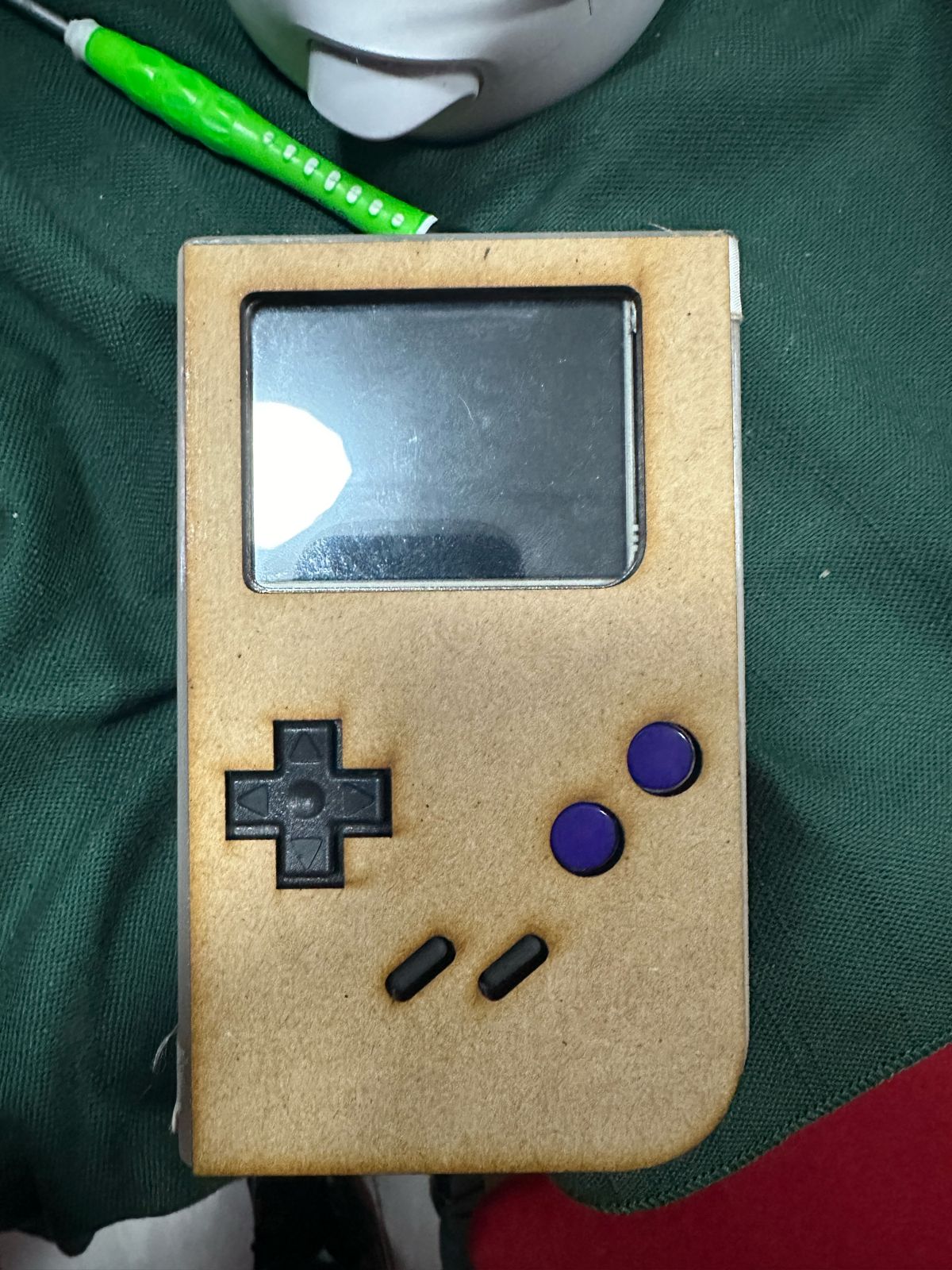
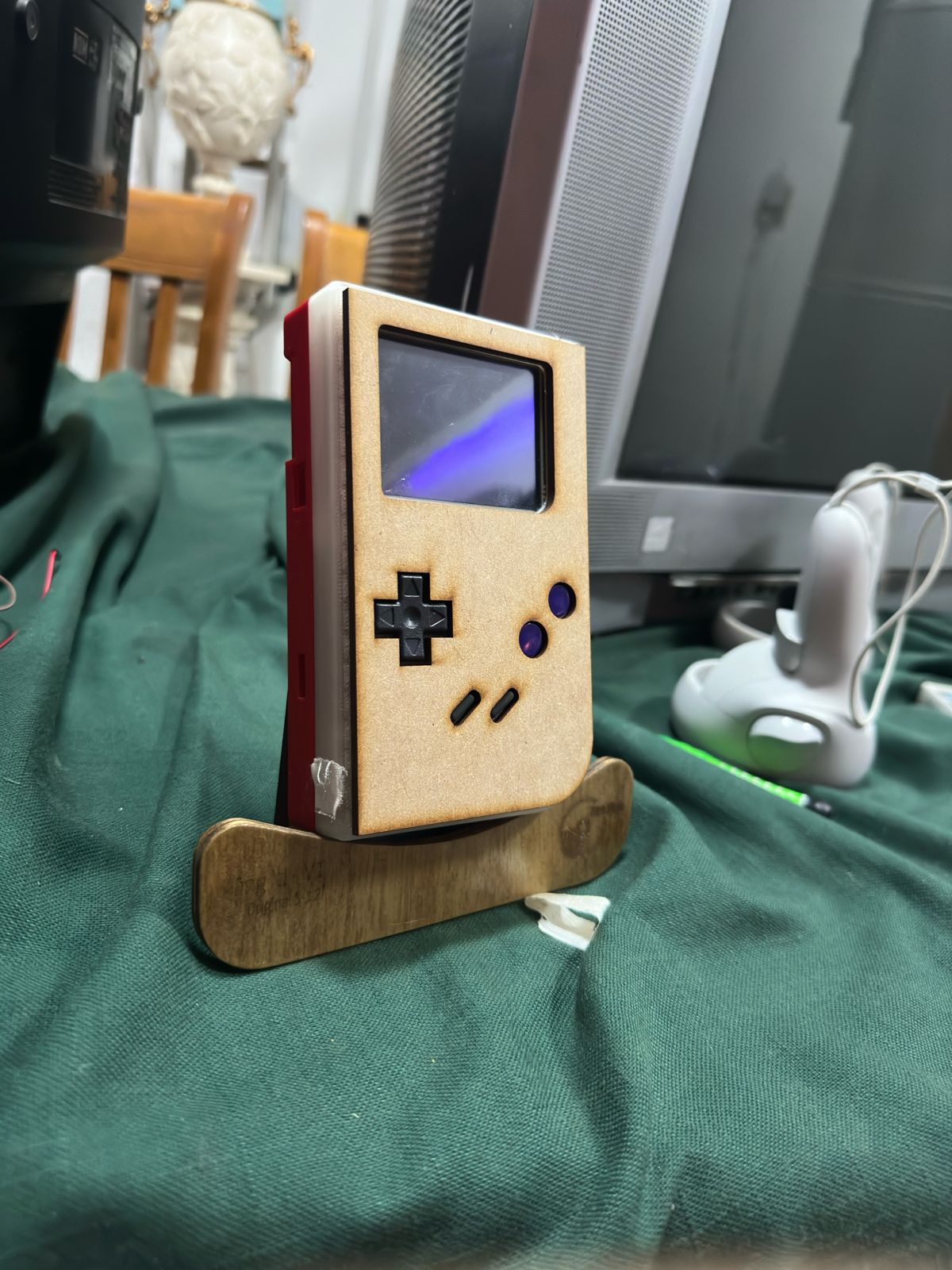
Electronics Design and Production:
All electronics design and production were conducted by me, providing a hands-on approach from the initial schematics to the final assembly of the PCB. This hands-on methodology ensured a deep understanding of every component's role within the system, enhancing the console's reliability and performance. If you want to see more progress you can see the documentation during the week of Electronic Design.
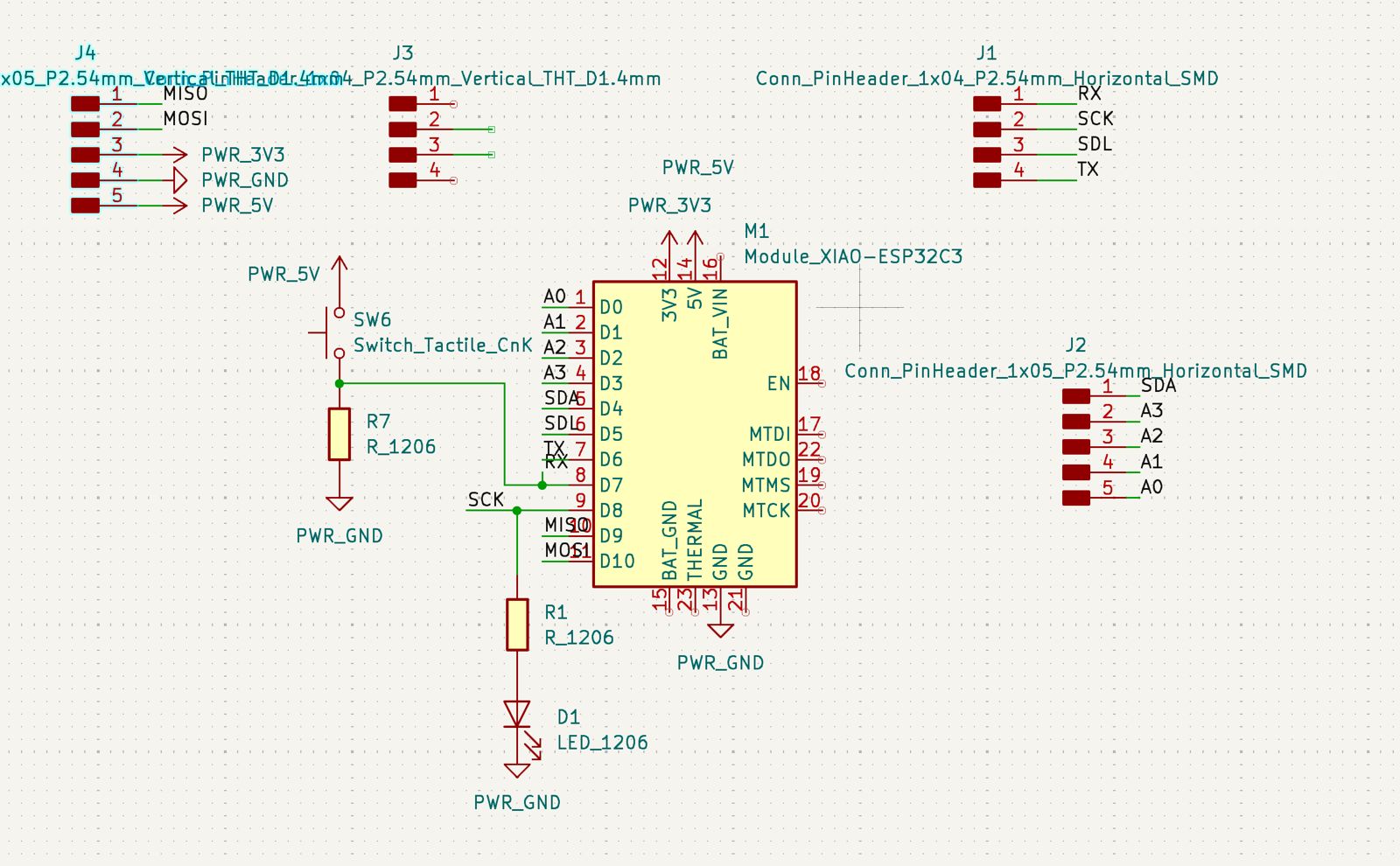

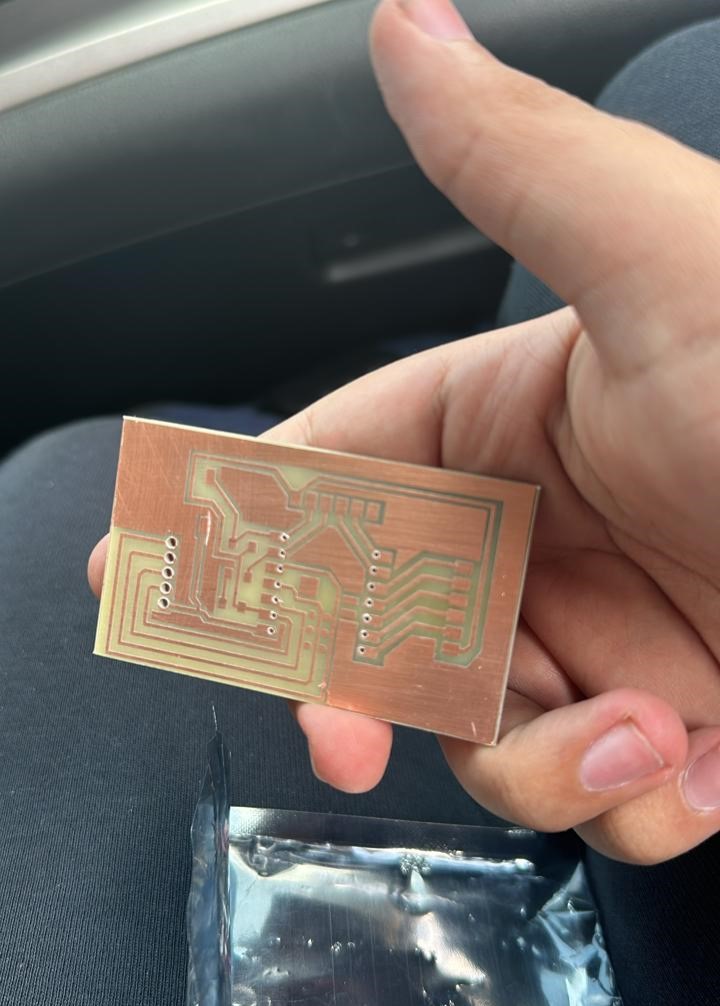

Here is the BOM (Bill of Materials) for the PCB:
| Qty | Description | Price | Link |
|---|---|---|---|
| 1 | XIAO ESP32S3 | 23.82$ | https://www.amazon.com.mx/dp/B0BYSB66S5?psc=1&ref=ppx_yo2ov_dt_b_product_details |
| 1 | XIAO ESP32C3 | 19$ | https://www.amazon.com.mx/Seeed-Studio-XIAO-ESP32C3-Microcontrolador/dp/B0B94JZ2YF/ref=sr_1_1?dib=eyJ2IjoiMSJ9.PJZ5qt6-xZ7WdePVkPq-uZGEIjak7KUfu-v_WzzGLBkBKkMsVs0fM9_ku60D_UlAkwFeU4IBo8sV8Ee2qVRmUJRYG5PFu_zphMw1BHtR_0d0T1cBKFRsRJCZbbNQV4udAy8e_jlQQVekKDejrkcN0Armi22hlVGNVS0yataA9HxTod14YOClgQSQEbpWxBMhQf2YQ2VyvSSd7ITf0-GKnS4yskJFCq7P5Mz6H9BMXaKMIkYQCl-_06u_y-qWA6cMngN1RbD5YRy2lto-tOCIU-zXA1-9HPcz74Q0XharMQI.RAqqOKgELwZFUeqH7NcQg5JuNUg83818NU8EOiU-6tg&dib_tag=se&keywords=xiaomi+esp32c3&qid=1718216930&sr=8-1&ufe=app_do%3Aamzn1.fos.242f5c11-6cfd-40d6-91f6-be3d1974080c |
| 20 | Pin Header | 10.88 $ | https://www.amazon.com.mx/HiLetgo-unidades-Pitch-Single-Header/dp/B07R5QDL8D/ref=sr_1_1?__mk_es_MX=ÅMÅŽÕÑ&crid=17JNBUBVSGQNI&dib=eyJ2IjoiMSJ9.UifjtcCY_nZn6sYFyOeC8XVBOIkJT4YIYxvFicKIW5UjEgeIzSP29kBBzRKob1O_LbMJIpwbNOKW2NCvqHFMcQou2OEzUDgmR0Oq6ReyHfoC41zFzEj5jWnon4rK_EKS1G3MJT4tLvEx4OB-52yCzjJGcQ4ljvtQF0g-tRdXo6ru4oaKZ0MmRFBrYLqHt7LoBprVPy4_ELsmTgrt3-DAouAtJN3Jq3tiiHrTW10MNbrfOr3IEVBNurFnqJjRfZud6V2ts71ys4iyj19Yoov2AdgkQiQtg9HB1crmbwgjQm8.c7ka9viVSfSjRHTujJSmcJIx8oTDdkpuq3OC3XAXxIU&dib_tag=se&keywords=pin+header&qid=1718216535&s=industrial&sprefix=pin+heade%2Cindustrial%2C113&sr=1-1&ufe=app_do%3Aamzn1.fos.242f5c11-6cfd-40d6-91f6-be3d1974080c |
| 1 | Copper Plate | 3.47$ | https://www.amazon.com.mx/Baquelita-20x30-Placa-Fenolica-Cobre/dp/B0BFC69CMD/ref=asc_df_B0BFC69CMD/?tag=gledskshopmx-20&linkCode=df0&hvadid=629844921294&hvpos=&hvnetw=g&hvrand=16577397819503830501&hvpone=&hvptwo=&hvqmt=&hvdev=c&hvdvcmdl=&hvlocint=&hvlocphy=9073959&hvtargid=pla-1945865227583&psc=1&mcid=3d41740f5319375b9048d93974134240 |
| 7 | 1k Resistances | 18.00$ | https://www.amazon.com.mx/dp/B0BZJXFFHF?psc=1&ref=ppx_yo2ov_dt_b_product_details |
| Total Cost: | 75.17$ |
Devices:
For input and output devices, the GameShine utilizes the aforementioned SNES buttons for input and the ILI9341 display for output, striking a balance between user interface simplicity and technological sophistication.
Output Devices:
During the week of Output Devices I found that the heart of the GameShine is its display technology—an ILI9341 LCD 2"8 display, which offers vibrant color output and fluid motion graphics, providing an immersive gaming experience right in the palm of your hand.

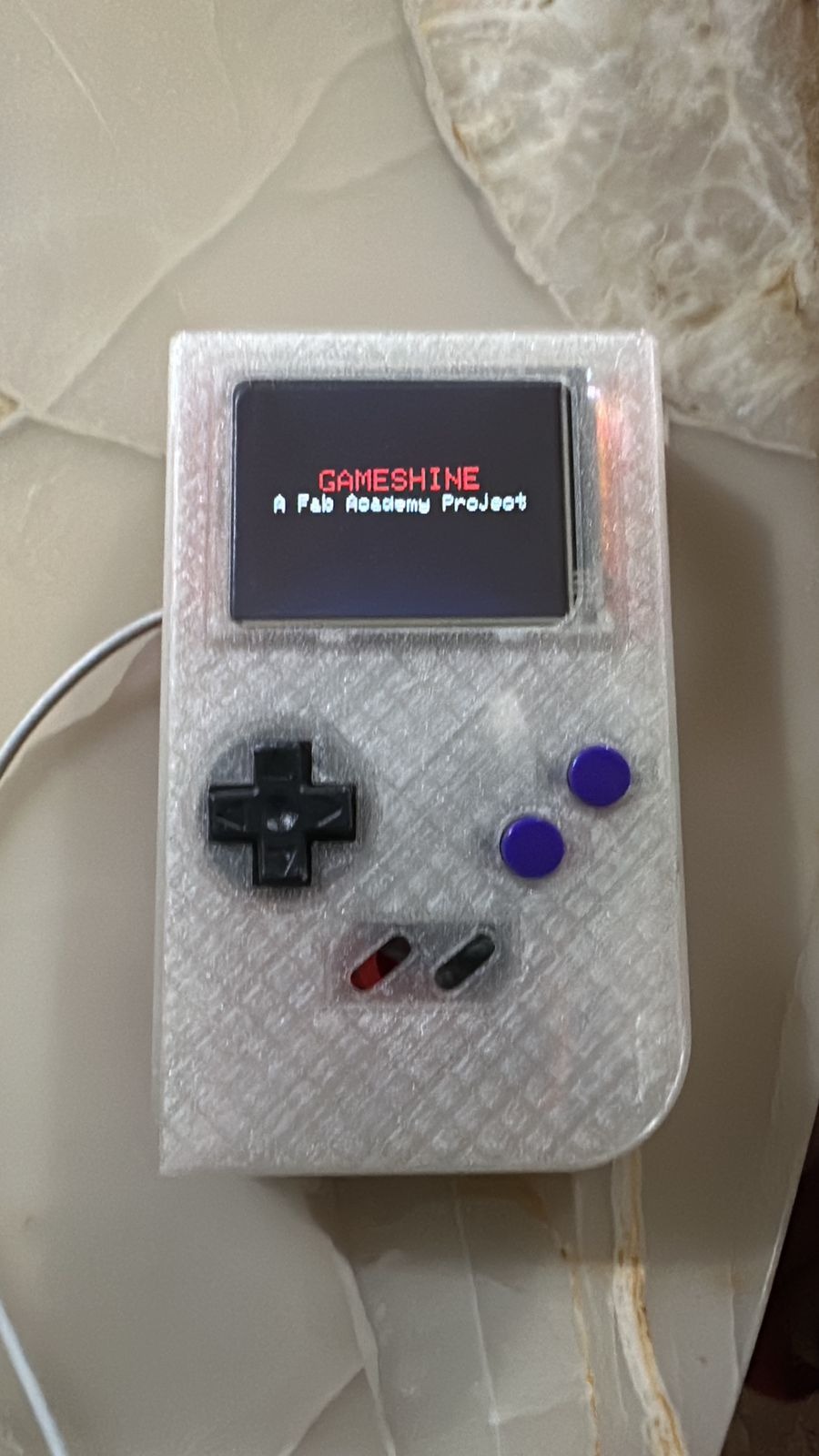
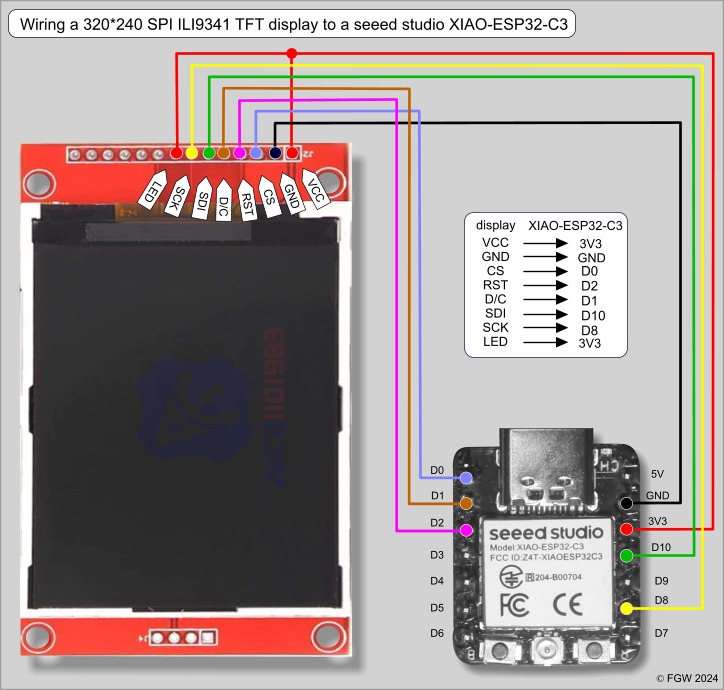
In order to test the output device I used the following code from Adafruit's ILI9341 Library:
Input Devices:
During the week of Input Devices in an ode to classic gaming, I've incorporated disassembled SNES controller buttons, which are connected to the touch pins on the XIAO ESP32S3. This setup not only pays tribute to the timeless design of the SNES controller but also takes advantage of the ESP32S3's capacity to handle touch inputs, offering a tactile and responsive control scheme that enhances player interaction.

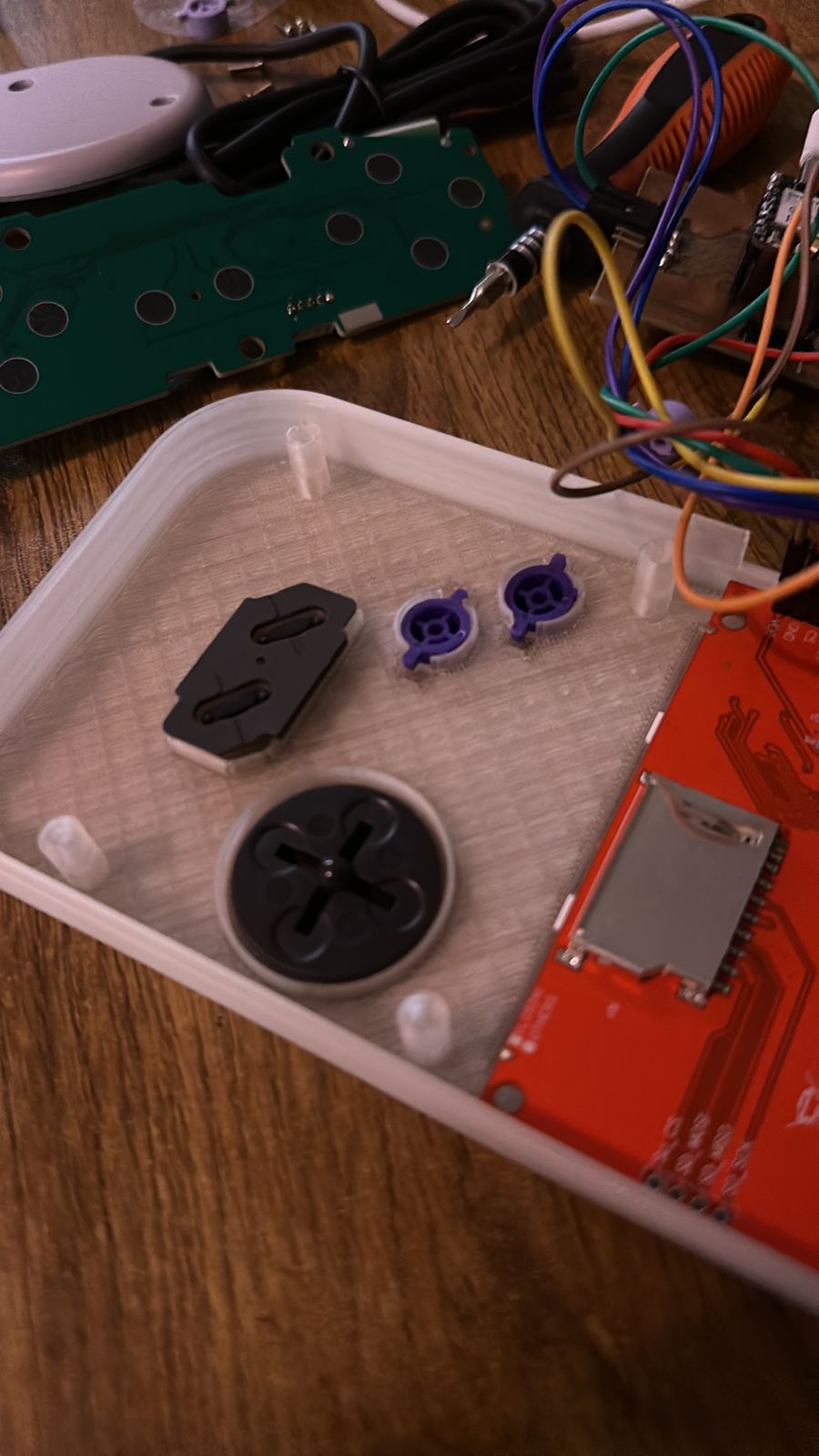
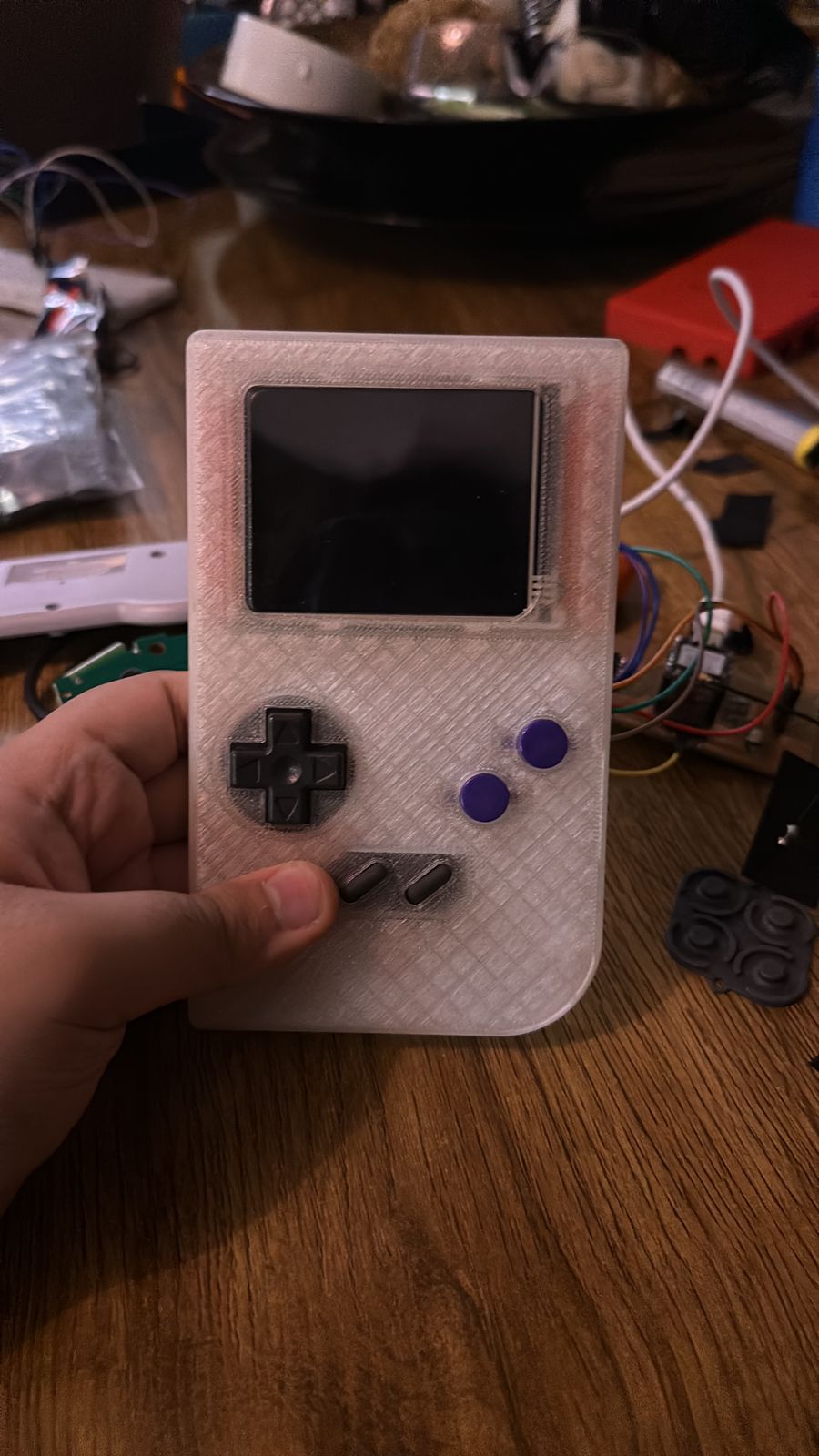
A unique aspect of the input system is the integration of SNES controller buttons with the touch mechanism of the XIAO ESP32S3. To achieve this, I modified the rubber button of the SNES controller by adding a jumper. When the button is pressed, it simulates a touch input. This is particularly innovative as it blends traditional physical button presses with touch sensitivity, enhancing the user interaction with the console.
System Integration:
The system integration process has involved rigorous testing and optimization to ensure that each component functions reliably within the ecosystem of the GameShine console, providing a robust platform for gaming and development.
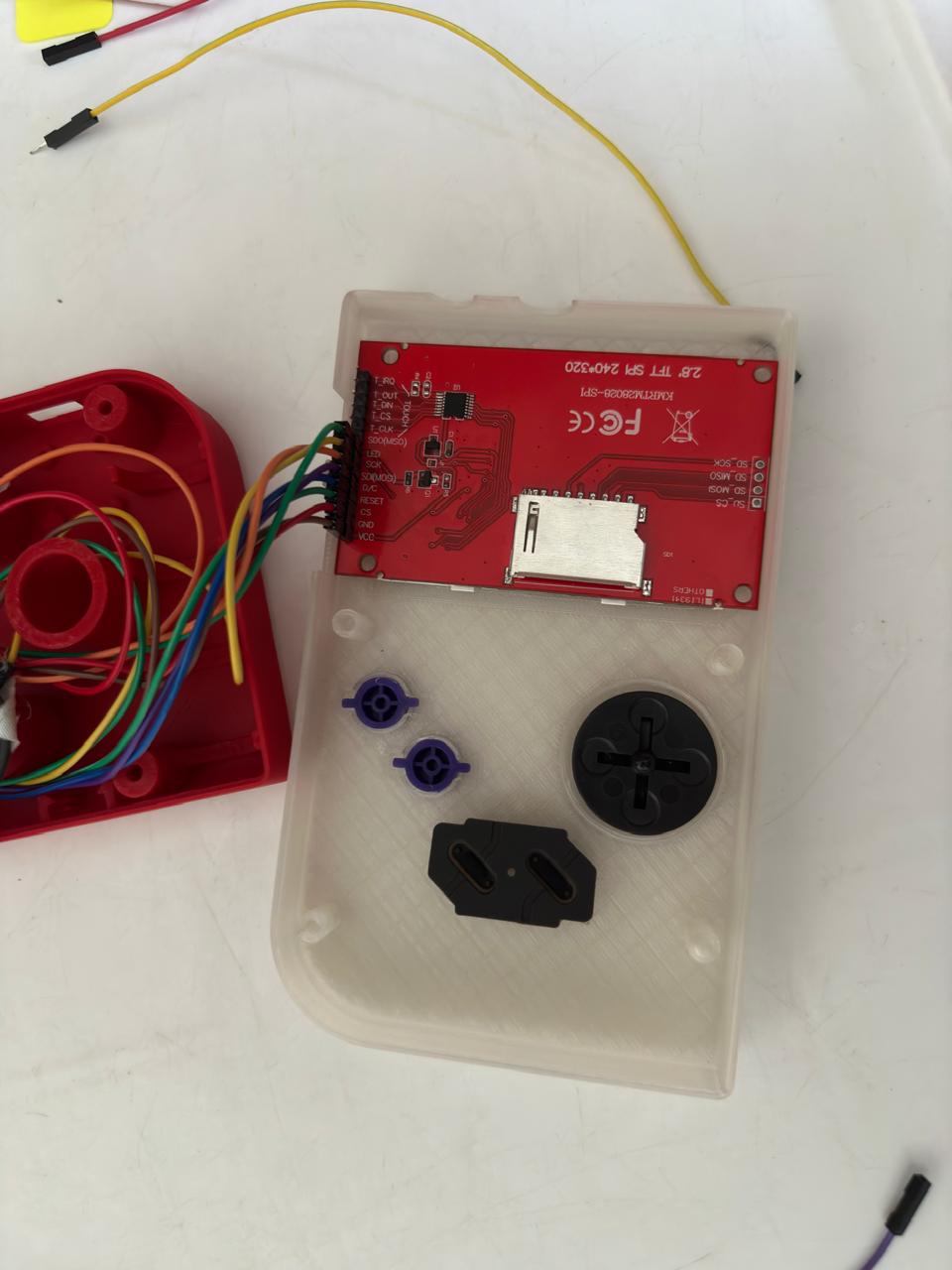
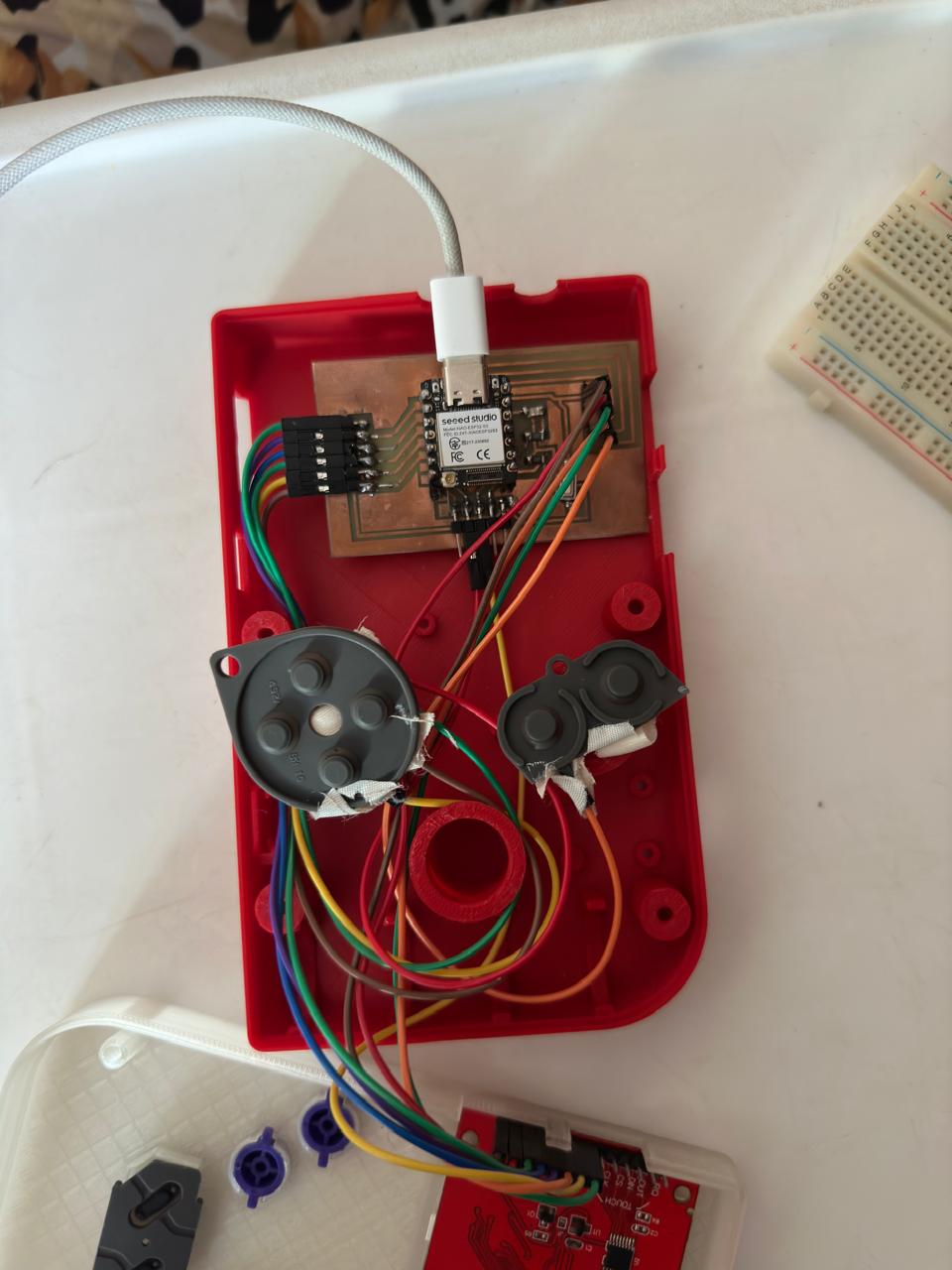
Embedded Microcontroller Interfacing and Programming:
The GameShine is not just about playing games—it's about creating them too. It supports programmable games, and to demonstrate this, I've included a preloaded game called "Space Trash" by Arnov Sharma, as well as my own creation, "GalaFab." These games showcase the console's capability to run diverse gaming genres from developers across the globe. Here is the Source Code:

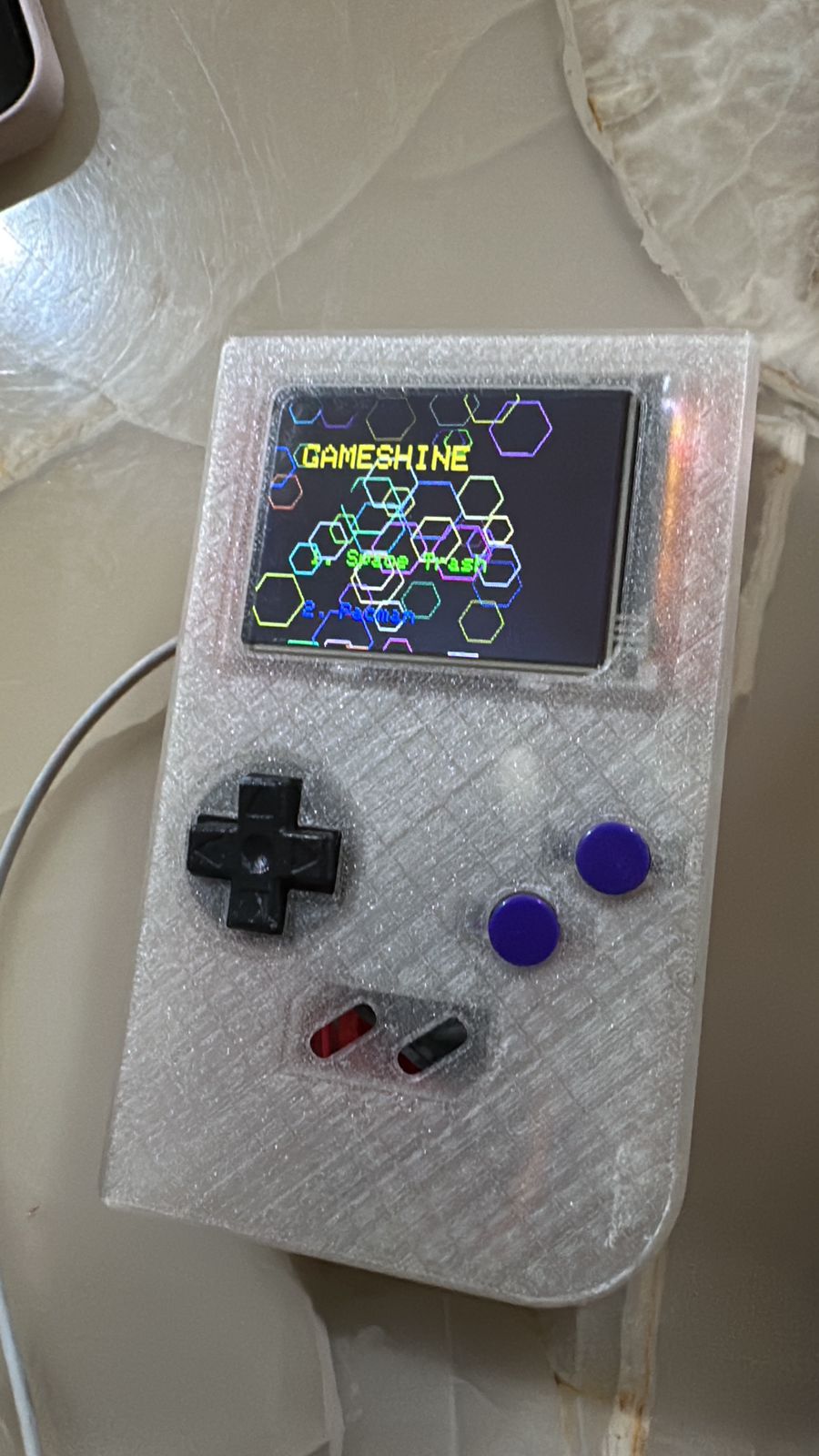

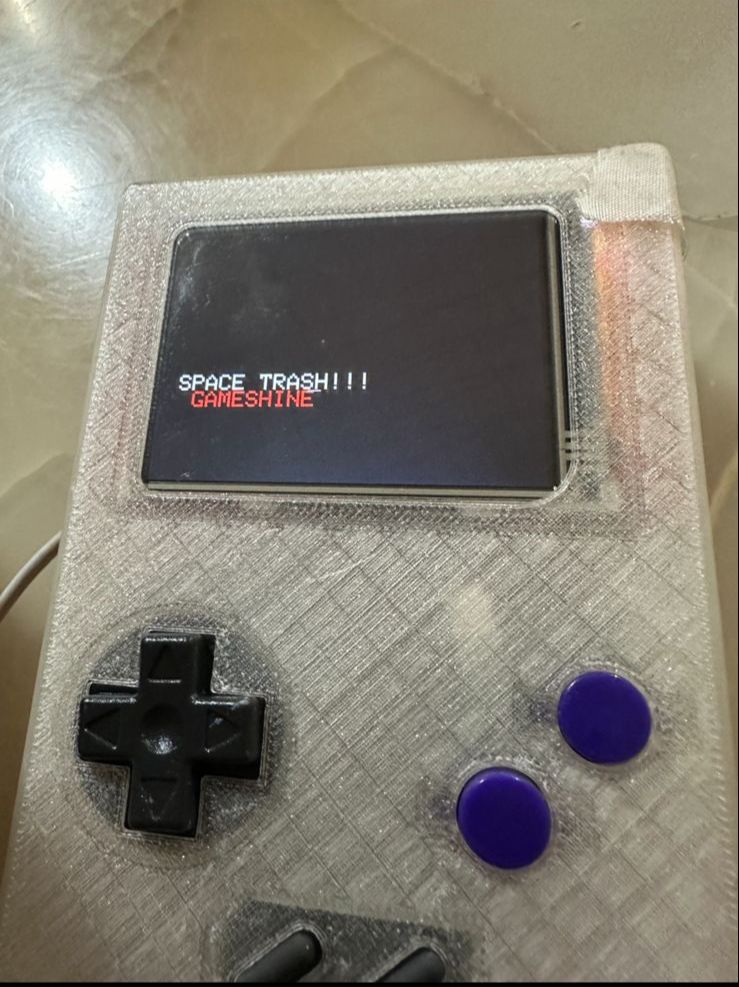

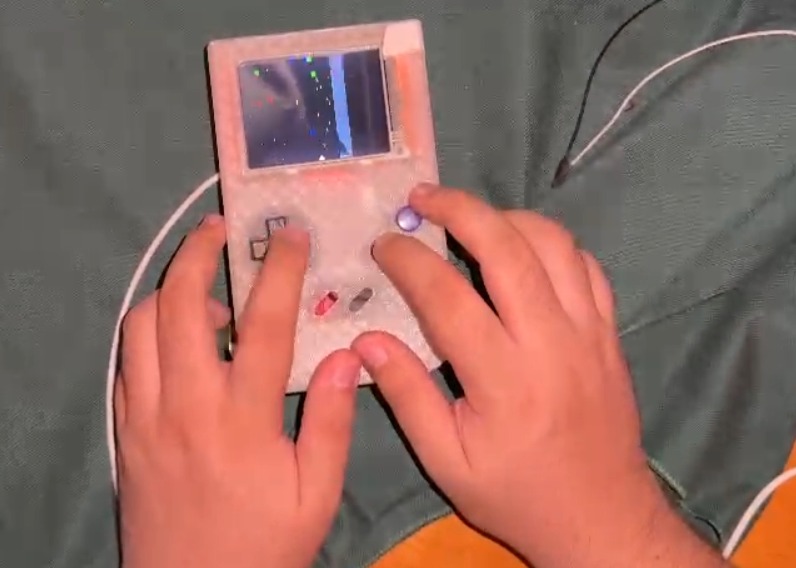
Project Calendar:
- Week 12
- Week 13
- Week 14
- Week 15
- Week 16
- Week 17
- Week 18
- Week 19
- Week 20
- Week 21
Bill of Materials:
Below is the complete list of all the materials to build your own GameShine. It includes links to the Amazon page of the materials.
| Qty | Description | Price | Link |
|---|---|---|---|
| 1 | PCB | 75.17$ | Manufactured by me |
| 1 | ILI9341 Display | 11.52$ | https://www.amazon.com.mx/dp/B0C4761ZJG?ref=ppx_yo2ov_dt_b_product_details&th=1 |
| 1 | PLA 1.75mm Transparent Filament | 11.46$ | https://www.amazon.com.mx/Filamento-SHANDABULIU-Impresión-Dimensional-Transparente/dp/B0C8SJQHQV/ref=asc_df_B0C8SJQHQV/?tag=gledskshopmx-20&linkCode=df0&hvadid=673223094394&hvpos=&hvnetw=g&hvrand=16798009837175887650&hvpone=&hvptwo=&hvqmt=&hvdev=c&hvdvcmdl=&hvlocint=&hvlocphy=9073959&hvtargid=pla-2249559725741&mcid=87c21040b6753b4ba8c89a825b73dc76&th=1 |
| 1 | PLA 1.75mm Red Filament | 23.94$ | https://www.amazon.com.mx/Filamento-impresora-Creality-resistente-dimensional/dp/B0BYDH6LYM/ref=sr_1_1_sspa?dib=eyJ2IjoiMSJ9.J_dudLTK78BizJWOnl4J9gmK7eUp3d_VdP4sHz3qjsTtoWgduoPmdIR-r2ebl7AITBwubhqCdp6Wa3L61Uu6Jbvkc81ecEeFnEwmO8pcqidWXqBNtdofrMeHd-p58sl5zpznR-rleL80oenrv399Wx7-I1CkfESzE07lqtb6--BX2i_k2VZZPWlCP0CmMyz1S78fAmxhiBx7Ng0zK5ff4gvx1jBepwT3TEs0oKe57wWPnxABNt2p_Dyfa8hdKZip6gymcBFLxNpsKrtn-b_kBcJu43hhAPMXJCvmuxYXBv4.wYVVZYV2zdA9szJ-gN1Q_zJJHEoFxjLw9s2OZ3OKihs&dib_tag=se&keywords=red%2Bfilament&qid=1718216773&sr=8-1-spons&ufe=app_do%3Aamzn1.fos.242f5c11-6cfd-40d6-91f6-be3d1974080c&sp_csd=d2lkZ2V0TmFtZT1zcF9hdGY&th=1 |
| 1 | SNES Controller | 23.62$ | https://www.amazon.com.mx/dp/B07JPQY66K?ref=ppx_yo2ov_dt_b_product_details&th=1 |
| Other (Soldering tin, DuPont Cables, Tape.) | 5$ | ||
| TOTAL: | 150.71$ |
FAQ:
-
What Will It Do?
- PCB Design: Custom layout integrating the XIAO ESP32C3 microcontroller, display drivers, power management, and connectivity features.
- Casing: Ergonomically designed casing with buttons and D-pad, utilizing 3D printing and molding for mass production.
- Software Interface: User-friendly interface for game navigation, downloads, and settings, plus the development environment for game creation.
- Electronics: Microcontrollers, display (LCD or OLED), batteries, speakers, PCB, LEDs, resistors, capacitors, diodes.
- Casing Materials: Plastics for molding, possibly rubber for grips, metal for structural components.
- Miscellaneous: Cables, screws, connectors.
- Microcontroller: $3-$5 per unit for the XIAO ESP32C3.
- Display: $10-$15 per unit.
- Battery: $5-$10 per unit.
- Complete BOM (Bill of Materials): Estimated total cost per unit for all components might range from $50-$100 depending on volume and sourcing.
- PCB and Electronic Systems: Including all integrated circuits, display systems, audio output, and power management.
- Mechanical Systems: Includes the casing, button assemblies, and any moving parts like the battery compartment.
- Software Systems: Firmware for the microcontroller and software for the user interface and connectivity features.
- PCB Manufacturing: Involving etching, drilling, and possibly multilayer fabrication.
- Injection Molding: For mass-producing the plastic components of the casing.
- 3D Printing: For prototyping and possibly for final production of certain custom parts.
- Lasercut: To make an MDF cover case.
- Assembly: Manual and/or automated assembly processes for putting together the electronic and mechanical components.
- Feasibility: Can the proposed features be integrated within the cost and size constraints?
- User Experience: Will the design be user-friendly and appealing to the target demographic?
- Scalability: Can the production be scaled to meet potential demand?
- Durability and Reliability: Will the device withstand regular use over an extended period?
- Testing: Both hardware and software will undergo rigorous testing, including user testing with target demographics for usability and satisfaction.
- FabAcademy Feedback: Post-launch feedback will be crucial to evaluate the success of the GameShine console in the market.
The GameShine console will provide a portable gaming experience with a focus on retro-inspired games along with modern titles. It will feature downloadable games, multiplayer capabilities through WiFi or Bluetooth, and programmable features that allow users to create and share their own games using MicroPython.
Who's Done What Beforehand?The concept of portable gaming consoles has a rich history, with major contributions from companies like Nintendo (Game Boy, Nintendo DS), Sony (PSP, PlayStation Vita), and more recently, with independent devices like the Raspberry Pi-based handhelds (Example: The Lameboy). These devices have explored various aspects of portable gaming technology, from hardware design to software ecosystems.
What Will You Design?The design elements include:
Components like microcontrollers, displays, and batteries will likely be sourced from electronic component suppliers and manufacturers, both domestic and international. Plastics and other raw materials for the casing may come from specialized suppliers in the plastics and composites industry.
How Much Will They Cost?The cost will vary based on the sourcing strategy and quantities ordered, but preliminary estimates include:
In the programming part I have enough knowledge to do really cool things, however, in the electronics part, I have very little knowledge and it is complicating a lot.
Files
Here you can find the .zip that contains all the files of my project.
© Copyright 2024 David Bojalil | This work is licensed under Creative Commons Attribution Non Commercial and GNU General Public License v3.0
.png)
